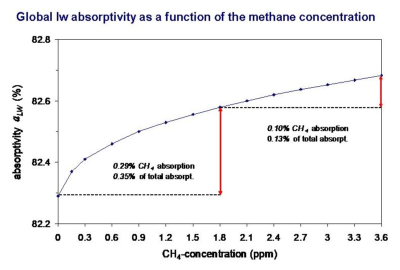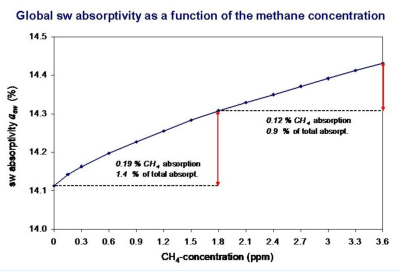
c) Methane Sensitivity
Due to the GWP-values (global warming potential) as published in the AR4 report of the IPCC, methane is classified to have a 72x greater potential for global warming than CO 2 over a time horizon of 20 years and 25x greater potential over 100 years, this dependent on the time, over which methane exists in the atmosphere (IPCC assumes a shorter lifetime of 12 years compar- ed to CO 2 with 55 years). Therefore, CH 4 is stronger weighted. Note, these lifetimes are absolutely speculative, from own actual studies of the carbon cycle (see sub-section d) the residence time of CO 2 is only about 4 yr. The radiative efficiency of methane with 3.7x10 -4 W/m 2 /ppb is also classified to be 25x larger than that of CO 2 with 1.4x10 -5 W/m 2 /ppb. Such values are derived from the changing absorp- tivity or emissivity of the gases, when their concentration is changing by 1 ppb (parts per bil- lion). But what people are doing is to compare cherries with pumpkins, two gases under com- pletely different conditions: CH 4 at a concentration of 1.8 ppm and CO 2 at a 200x larger con- centration, when it is already strongly saturated. Also the interference with the other green- house gases, particularly with WV is for both gases completely different. Only these diverse conditions pretend a much higher radiative efficiency of methane, resp a too low value for CO 2 . So, at a concentration of 400 ppm the radiative efficiency of CH 4 drops to about half of that of CO 2 , and at a concentration of 1.8 ppm the efficiency of CO 2 is about twice that value specified for CH 4 . Therefore, to compare what CH 4 will really contribute to global warming, can only be determin- ed by analogous calculations to the CO 2 case, and this also for the same relative concentration changes, e.g. a doubling of the respective concentrations. Calculations of the absorptivities as a function of the CH 4 concentration then take place on a scale two hundred times smaller, now from 0 to 3.6 ppm. They were performed for global con- ditions with a water vapor concentration of 14,614 ppm, CO 2 of 380 ppm, a temperature of 16 °C and a lapse rate of 6.5 °C/km. The variation of the sw absorptivity over this scale with 0.31 % is 3x smaller than the respective changes in the CO 2 case over 760 ppm, and within this range we only see little saturation ef- fects. On the other hand, the lw absorptivity already suffers from medium saturation despite of these low concentrations. This different behavior of sw and lw absorptivities is in so far of some importance as the domi- nating lw absorption contributes to an ascending Earth-temperature but already shows clear saturation at doubled concentration, while an increasing sw atmospheric absorptivity contri- butes to a reduced surface absorption and thus a smaller surface heating with higher concen- trations. With these absorptivities of CH 4 and otherwise identical parameters as used for CO 2 , simula- tion with the two-layer model gives a CH 4 sensitivity as temperature increase at doubled concentration of only EMS = 0.016 °C, which is 44x smaller than CO 2 under these conditions. Therefore, methane has no noticeable effect as GH-gas for global warming, and the same holds for nitrous oxide.

Physics & Climate















